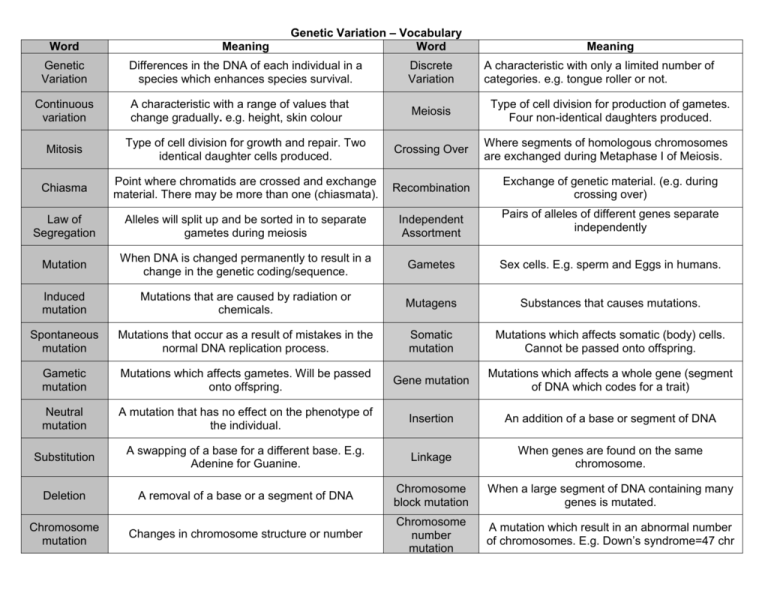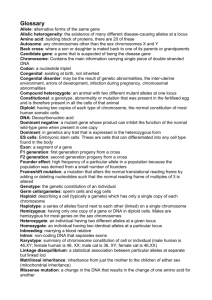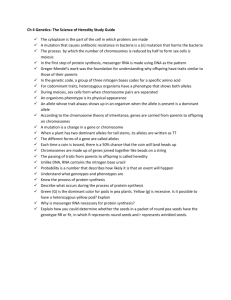Genetic Variation – Vocabulary
advertisement

Genetic Variation – Vocabulary Word Word Meaning Genetic Variation Differences in the DNA of each individual in a species which enhances species survival. Discrete Variation A characteristic with a range of values that change gradually. e.g. height, skin colour Meiosis Continuous variation Meaning A characteristic with only a limited number of categories. e.g. tongue roller or not. Type of cell division for production of gametes. Four non-identical daughters produced. Mitosis Type of cell division for growth and repair. Two identical daughter cells produced. Crossing Over Where segments of homologous chromosomes are exchanged during Metaphase I of Meiosis. Chiasma Point where chromatids are crossed and exchange material. There may be more than one (chiasmata). Recombination Exchange of genetic material. (e.g. during crossing over) Law of Segregation Alleles will split up and be sorted in to separate gametes during meiosis Independent Assortment Pairs of alleles of different genes separate independently Mutation When DNA is changed permanently to result in a change in the genetic coding/sequence. Gametes Sex cells. E.g. sperm and Eggs in humans. Induced mutation Mutations that are caused by radiation or chemicals. Mutagens Substances that causes mutations. Spontaneous mutation Mutations that occur as a result of mistakes in the normal DNA replication process. Somatic mutation Mutations which affects somatic (body) cells. Cannot be passed onto offspring. Gametic mutation Mutations which affects gametes. Will be passed onto offspring. Gene mutation Mutations which affects a whole gene (segment of DNA which codes for a trait) Neutral mutation A mutation that has no effect on the phenotype of the individual. Insertion An addition of a base or segment of DNA Substitution A swapping of a base for a different base. E.g. Adenine for Guanine. Linkage When genes are found on the same chromosome. Deletion A removal of a base or a segment of DNA Chromosome block mutation When a large segment of DNA containing many genes is mutated. Chromosome mutation Changes in chromosome structure or number Chromosome number mutation A mutation which result in an abnormal number of chromosomes. E.g. Down’s syndrome=47 chr Translocation A mutation which has moved one segment of a chromosome to a different position in the genome Polyploidy Having one or more extra sets of chromosomes Aneuploidy A mutation in which there is extra copies or missing copies of specific chromosomes Gene Segment of DNA that codes for a particular protein (characteristic) Allele Alternative forms of a gene at a locus Locus Position on a chromosome where a gene is Genotype The genetic make up of an individual (shown as letters or words e.g. homozygous dominant) Phenotype The physical appearance of a gene Heterozygous Having two different alleles Homozygous Having two alleles that are identical Dominant The allele which if present is always expressed in the phenotype Recessive Two copies of this allele are needed before being expressed in the phenotype True Breeding Cross between two homozygous parents (dominant and recessive) Carrier An individual which has one recessive gene, but does not express the recessive trait. F1 Generation The offspring resulting from true breeding parents (first filial generation) F2 Generation Offspring from the inbreeding of the f1 generation Incomplete Dominance Where an allele for a specific trait is not completely dominant over the other. E.g. Red+White = pink Monohybrid Cross A cross involving one pair of contrasting characters Lethal Genes Any gene that causes the death of the organism at any stage of life. E.g. yellow mice allele. Co-dominance Where both alleles in a heterozygote are fully expressed. E.g. red + white=red & white patches Trait A physical characteristic which is inheritable Multiple alleles Where three or more alleles can determine the phenotype. E.g. ABO blood type Sex Linked A trait which is determined by a gene located on the X or Y chromosome is called sex lined. Autosome Non-sex chromosome Linkage When certain genes or alleles tend to be inherited together Dihybrid Cross Cross involving two characteristics









